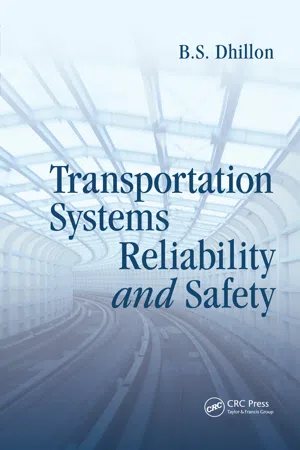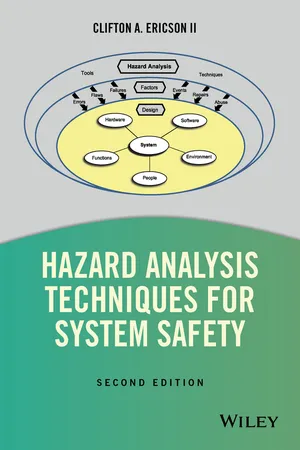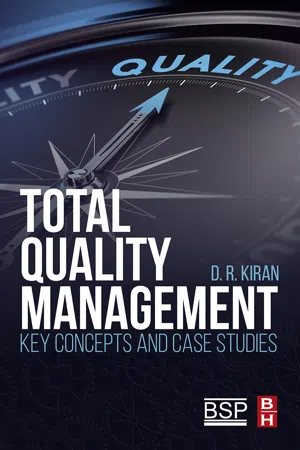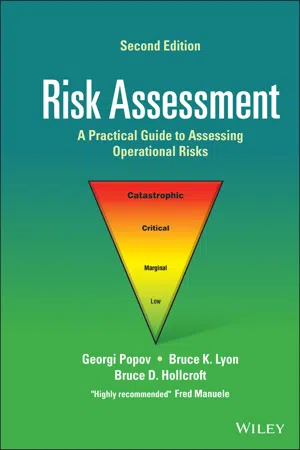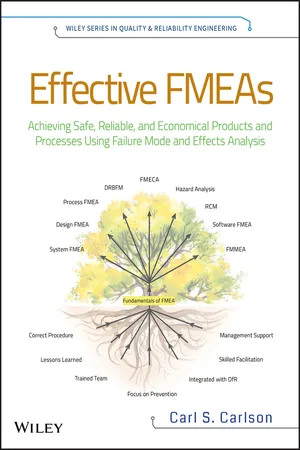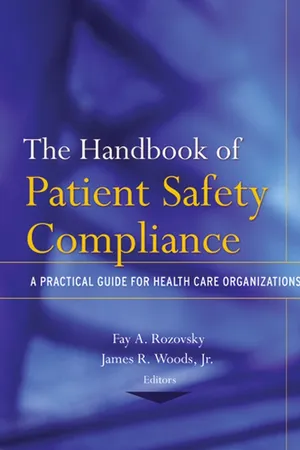Technology & Engineering
FMEA Risk Analysis
FMEA (Failure Mode and Effects Analysis) Risk Analysis is a systematic method for identifying and prioritizing potential failure modes in a process, product, or system. It involves assessing the severity, occurrence, and detection of each failure mode to determine its overall risk priority. This analysis helps organizations proactively address potential issues and improve the reliability and safety of their products or processes.
Written by Perlego with AI-assistance
Related key terms
1 of 5
12 Key excerpts on "FMEA Risk Analysis"
- B.S. Dhillon(Author)
- 2016(Publication Date)
- CRC Press(Publisher)
4.2 Failure Modes and Effect Analysis (FMEA) FMEA is a widely used design tool to analyze the reliability of engineer-ing systems; it can be described as an approach for analyzing the effects 56 Transportation Systems Reliability and Safety © 2011 by Taylor & Francis Group, LLC of potential failure modes in the system [6]. The history of FMEA goes back to the early years of the 1950s with the development of flight con-trol systems, when the U.S. Navy’s Bureau of Aeronautics developed a requirement known as failure analysis to establish a mechanism for reli-ability control over the detail design effort [7]. Subsequently, the term failure analysis was changed to failure modes and effect analysis (FMEA). The seven main steps that are normally followed to perform FMEA are shown in Figure 4.1 [2, 6]. There are a number of factors that must be explored with care prior to the implementation of FMEA. Some of the factors are as follows [8, 9]: • Examination of each conceivable failure mode by the involved professionals • Measuring costs/benefits • Obtaining engineer’s approval and support • Making decisions based on the risk priority number Over the years, professionals involved with reliability analysis have estab-lished certain guidelines/facts concerning FMEA. Four of these guidelines/ facts are shown in Figure 4.2 [8].- eBook - PDF
Six Sigma and Beyond
Design for Six Sigma, Volume VI
- D.H. Stamatis(Author)
- 2002(Publication Date)
- CRC Press(Publisher)
That disciplined technique is the FMEA. A process FMEA is an analytical technique that identifies potential product-related process failure modes, assesses the potential customer effects of the failures, identifies the potential manufacturing or assembly process causes, and identifies significant process variables to focus controls for prevention or detection of the failure conditions. (Also, process FMEAs can assist in developing new machine or equipment processes. The methodology is the same; however, the machine or equip-ment being designed would be considered the product.) A machinery FMEA is a methodology that helps in the identification of possible failure modes and determines the cause for and effect of these failures. The focus of the machinery FMEA is to eliminate any safety issues and to resolve them according to specified procedures between customer and supplier. In addition, the purpose of this particular FMEA is to review both design and process with the intent to reduce risk. All FMEAs utilize occurrence and detection probability in conjunction with severity criteria to develop a Risk Priority Number (RPN) for prioritization of corrective action considerations. This is a major departure in methodology from the Failure Mode and Critical Analysis (FMCA), which focuses primarily on the severity of the failure as a priority characteristic. 224 Six Sigma and Beyond In its most rigorous form, an FMEA summarizes the engineer’s thoughts while developing a process. This systematic approach parallels and formalizes the mental discipline that an engineer normally uses to develop processing requirements. DEFINITION OF FMEA FMEA is an engineering “reliability tool” that: 1. Helps to define, identify, prioritize, and eliminate known and/or potential failures of the system, design, or manufacturing process before they reach the customer, with the goal of eliminating the failure modes or reducing their risks 2. - eBook - ePub
- Clifton A. Ericson, II(Authors)
- 2015(Publication Date)
- Wiley(Publisher)
Chapter 16 Failure Mode and Effects Analysis16.1 FMEA Introduction
Failure mode and effects analysis (FMEA) is a tool for evaluating the effect(s) of potential failure modes of subsystems, assemblies, components, or functions. It is primarily a reliability tool to identify failure modes that would adversely affect the overall system reliability. FMEA has the capability to include failure rates for each failure mode, in order to achieve a quantitative probabilistic analysis. Additionally, the FMEA can be extended to evaluate failure modes that may result in an undesired system state, such as a system hazard, and thereby also be used for hazard analysis.A more detailed version of the FMEA is known as failure mode, effects, and criticality analysis (FMECA). The FMECA requires that more information be obtained from the analysis, particularly information dealing with the criticality and detection of the potential failure modes.FMEA is a disciplined bottom-up evaluation technique that focuses on the design or function of products and processes, in order to prioritize actions to reduce the risk of product or process failures. In addition, the FMEA is a tool for documenting the analysis and capturing recommended design changes. Time and resources for a comprehensive FMEA must be allotted during design and process development, when design and process changes can most easily and inexpensively be implemented.16.2 FMEA Background
FMEA falls under the detailed design hazard analysis type (DD-HAT) because it is an analysis done at the component or functional level based on detailed system design. The basic hazard analysis types are described in Chapter 4 .An alternate name for this technique is FMECA. FMECA is basically the same as FMEA, except that it adds criticality evaluation to each failure mode, as well as the evaluation of possible failure mode detection methods. - eBook - ePub
Total Quality Management
Key Concepts and Case Studies
- D.R. Kiran(Author)
- 2016(Publication Date)
- Butterworth-Heinemann(Publisher)
Every product or project undertaken by the engineer is an experiment because each stage of the design or development is experienced for the first time. There are uncertainties at every stage, and the engineer is bound to make presumptions, either from data, books, or from his experience. These uncertainties can be in the form of:• models used for the design calculations,• performance characteristics of the materials,• inconsistencies in the materials purchased,• nature of the pressure the finished product will encounter,• size of the product, whether a medium-sized product or a large-sized product,• volume of production, viz, batch production or mass production,• specialized materials and skills used in the manufacture.Apart from the above, the engineer may also experience uncertainties from the viewpoint of several other variables in the development.26.2 Failure Modes and Effects Analysis
Failure mode and effects analysis (FMEA) is one of the best management tools to analyze the potential failure modes within a system under conditions of uncertainties, as stated above. Its principle is quite basic, and has been practiced since the olden days as the trial and error method. But since learning from each failure is both costly and time-consuming, the modern form of FMEA was developed during the 1940s, as explained in the following section. It emphasizes the probability of occurrence of that failure, and the severity of its effect on the system of every uncertainty. It is used to identify potential failure modes, determine their effect on the operation of the product, and identify actions to mitigate the failures. It analyzes potential reliability problems early in the development cycle, where it is easier to take actions to overcome these issues, thereby, enhancing reliability through design. FMEA should always be done whenever failures would mean potential harm or injury to the user of the end item being designed. According to Besterfield et al., FMEA is a “before-the-event ” action requiring a team effort to easily and inexpensively alleviate changes in design and production - eBook - ePub
Risk Assessment
A Practical Guide to Assessing Operational Risks
- Georgi Popov, Bruce K. Lyon, Bruce D. Hollcroft(Authors)
- 2021(Publication Date)
- Wiley(Publisher)
8 Failure Mode and Effects Analysis Georgi Popov1 and Bruce Lyon2 1 University of Central Missouri 2 Brown & BrownOBJECTIVES
- Introduction, Overview, and Background
- Purpose and Use
- Practical Application
- Examples
- Practice Exercises/Questions
8.1 Introduction
Failure Mode and Effects Analysis (FMEA) is one of the most commonly used techniques for hazard analysis and risk assessment. As its name implies, FMEA is used to identify and analyze the ways in which system components can fail to fulfill their designed intent, and the resulting effects to the system. To state plainly, FMEA focusses on failures and their effects to understand how each failure can be prevented and their effects reduced. It is generally considered a qualitative or semiquantitative method that lists systematically the failure modes, their effects, existing safeguards, and any additional controls that are needed to reduce risk to an acceptable level.Traditionally, the FMEA method has been used as a form of “reliability” analysis of systems, subsystems, processes, and hardware. However, FMEA can also be used to analyze jobs and individual tasks, to identify potential deviations from desired performance criteria that can cause failures (exposure to hazards), how these failures can occur, and their resulting effect on the workers, as well as the work environment. This chapter will address the practical use of the FMEA technique in identifying failure modes and their effects, existing control measures, and ranking systems according to their importance or criticality. The text will provide qualitative and semiquantitative information for additional analytical techniques such as Bow‐Tie analysis.FMEA, one of the first failure analysis methods, was developed by the United States (US) Department of Defense (DoD) in 1949. It was originally published in the Military Procedure, MIL‐P‐1629 – Procedures for performing a failure mode effect and critical analysis, - eBook - ePub
Effective FMEAs
Achieving Safe, Reliable, and Economical Products and Processes using Failure Mode and Effects Analysis
- Carl Carlson, Carl S. Carlson(Authors)
- 2012(Publication Date)
- Wiley(Publisher)
Chapter 3 Understanding the Fundamental Definitions and Concepts of FMEAs Intellectuals solve problems, geniuses prevent them. —Albert EinsteinIN THIS CHAPTER
What exactly is Failure Mode and Effects Analysis (FMEA) and what are its key concepts and definitions? This chapter explains the different types of FMEAs and tells how each is used. The majority of the chapter covers a thorough explanation of the key words and concepts of FMEA, each illustrated with multiple application examples for different types of FMEAs.3.1 DEFINITION OF FMEA
Failure Mode and Effects Analysis (FMEA) is a method designed to:- Identify and fully understand potential failure modes and their causes, and the effects of failure on the system or end users, for a given product or process.
- Assess the risk associated with the identified failure modes, effects, and causes, and prioritize issues for corrective action.
- Identify and carry out corrective actions to address the most serious concerns.
An FMEA is an engineering analysis done by a cross-functional team of subject matter experts that thoroughly analyzes product designs or manufacturing processes early in the product development process. Its objective is finding and correcting weaknesses before the product gets into the hands of the customer.An FMEA should be the guide to the development of a complete set of actions that will reduce risk associated with the system, subsystem, and component or manufacturing/assembly process to an acceptable level.Performing an FMEA just to fill a checkbox in the Product Development Process and then filing it away, never to be seen again, is a waste of time and adds no value. If not for use as guidance through the development process, why waste the time and resources to do it in the first place? If effectively used throughout the product life cycle, it will result in significant improvements to reliability, safety, quality, delivery, and cost. - eBook - ePub
Reliability Culture
How Leaders Build Organizations that Create Reliable Products
- Adam P. Bahret(Author)
- 2021(Publication Date)
- Wiley(Publisher)
10 Risk Analysis Guided Project ManagementWe have limited resources and limited time. We would like to select and adhere to a method to choose where to apply resources. I firmly believe that assessed risk is the best way to do this. Using risk assessment to guide program activities is a process of:- Selecting tools that can translate product performance and program success risk to quantitative values.
- Use these values to prioritize the most critical areas of the product and program to address.
- Create a summary of these quantitative risk rankings that assigns specific tools to measure and mitigate these risks.
- Create a program plan that applies the available resources to these items in rank order until time and resources run out.
Failure Mode Effects Analysis Methodology
A Failure Mode Effects Analysis (FMEA ) looks to take speculative failure modes and their effects and make them quantifiable so that they can be ranked from highest to lowest risk. FMEAs can be used in programs for many purposes.I have noticed in my career that simply uttering the word FMEA creates a “cringe” in the room. I would believe that if I were to choose the phrase that best describes how many teams feel about FMEAs it would be what was said to me after I did a “lunch and learn.” “I get what you are saying about the value of FMEAs, but we have been a bit traumatized by them in the past.” Traumatized?! The team lead actually used the word “traumatized.”But that is not an uncommon experience and the negative effects are real. FMEAs are a true double‐edged sword. I sincerely believe they are one of the most valuable cornerstones to any reliability and product development program, if done correctly. Like anything else that is powerful, it's just as easy to cut off your own leg with it if you don't know what you are doing.Simply put, a badly run FMEA is something you would wish upon your competitors. It wastes time, drains morale, and doesn't provide any valuable program or design input. What more could you hope for for the other guy with a product next to yours on the store shelf? - eBook - ePub
The Handbook of Patient Safety Compliance
A Practical Guide for Health Care Organizations
- Fay A. Rozovsky, James R. Woods, Fay A. Rozovsky, James R. Woods, Jr.(Authors)
- 2016(Publication Date)
- Jossey-Bass(Publisher)
CHAPTER FOUR FAILURE MODES AND EFFECTS ANALYSIS : The Risks and the Rewards in Health Care Robert J. LatinoFailure modes and effects analysis … what a complex sounding and intimidating name! Although the FMEA methodology has been around for decades, it is relatively new to the health care world. The very name itself, failure modes and effects analysis, suggests that engineers had a hand in its original development. Engineers, known for their left-brain tendencies, are stereotyped as logical individuals who plan and structure everything. Seen through an engineer’s eyes, the world is a complex system in which the known sciences must apply to solve all problems.Contrast this to what engineers are not characteristically known for—that is their right-brain tendencies or the ability to be creative and think in the abstract or in concepts (versus the definitiveness of known science). Herein lies the crossroads at which FMEA meets health care. Recent efforts by the Joint Commission on Accreditation of Healthcare Organizations (JCAHO) attempt to utilize FMEA and apply it to health care systems. This is an admirable effort and, this author believes, a well-founded one. However, the cultural differences between industry and health care must be taken into consideration and accounted for in order for this initiative to be successful.Traditional FMEA Roots
Start with an understanding of the original intent of FMEA. It is a foundation for determining what modifications would be appropriate for FMEA in the health care environment. Consider that the FMEA technique was born in the aircraft industry, and FMEA is most widely known for its applicability to aircraft design. It has since been applied successfully to an array of equipment and systems issues in the continuous process and batch-processing industries. When designing an aircraft, aerospace engineers naturally are very interested in learning the answer to this question, What could be the effects on the equipment and the entire aircraft if a component would fail? It is important to emphasize the term could because traditional FMEA focuses on what might go wrong, not what has - eBook - PDF
Repairable Systems Reliability Analysis
A Comprehensive Framework
- Rajiv Nandan Rai, Sanjay Kumar Chaturvedi, Nomesh Bolia(Authors)
- 2020(Publication Date)
- Wiley-Scrivener(Publisher)
125 Rajiv Nandan Rai, Sanjay Kumar Chaturvedi and Nomesh Bolia. Repairable Systems Reliability Analysis: A Comprehensive Framework, (125–142) © 2020 Scrivener Publishing LLC 6 FMEA for Repairable Systems Based on Repair Effectiveness Index 6.1 Introduction Every industry following reliability practices and standards invariably uses failure mode and effect analysis/criticality analysis (FMEA/CA) for its product and/or process where risk priority number (RPN)–based approach has taken the front seat than the approach suggested in MIL- STD 1629A—a defunct and disowned standard by its propounder. A traditional RPN is an arithmetic products of three factors, viz., Severity of the effects of a failure mode, Occurrence frequency of its causes and means of Detectability of such mode in the design/process/service, i.e., RPN = S × O × D. These three factors are normally assessed, subjec- tively and/or objectively, through a customized 10- or 5-point scale for each factor [1] for that particular product or process. These three scales are constructed from experts’ opinion and/or the use of available data of that particular product/process. Ideally, FMEA begins during the earliest conceptual stages of design and continues throughout the life of the product or service. Begun in the 1940s by the U.S. military, FMEA is a step-by-step approach for identifying all possible failures in a design, a manufacturing or assembly process, or a product or service. Failure modes means the ways, or modes, in which something might fail. Failures are any errors or defects, especially ones that affect the cus- tomer, and can be potential or actual. Effects analysis refers to studying the consequences of those failures. Failures are prioritized according to how serious their consequences are, how frequently they occur, and how easily they can be detected. - eBook - PDF
Managing Supply Chain Risk
Integrating with Risk Management
- Sime Curkovic, Thomas Scannell, Bret Wagner(Authors)
- 2015(Publication Date)
- CRC Press(Publisher)
For each risk, they would assess what the financial impact would be in the event of a disruption. They then assigned a probability to each risk area and then they prioritized by multiplying the financial impact by the risk probability. Again, most firms are only using existing supply chain applications for managing risk with no formal risk management system in place. In the absence of risk management applica-tions, these firms are building risk considerations into traditional supply applications (e.g., spend, contract, and inventory management, demand planning, benchmarking, building long-term partnerships, etc.). The case below highlights how FMEA is used to mitigate supply chain risks at an office furniture manufacturer that has requested to remain anonymous and will henceforth be referred to as Company1. Using FMEA for Supply Chain Risk Management • 33 COMPANY1 BACKGROUND Company1 is a global, publicly traded company with a 2012 revenue of $2.75 billion and around 10,000 employees. They compete in the global office furniture industry with a portfolio that addresses three core elements of an office environment: interior architecture, furniture, and technology. Suppliers provide design, production, and service support and are a key to Company1’s success. Suppliers are evaluated and selected using a range of criteria including sustainable business practices, financial stability, legal and ethical compliance, quality, cost, delivery, and technical competence. Failure Mode and Effects Analysis In rare cases of extremely high risk, Company1 may conduct a complete FMEA. Only one FMEA in the supply chain has been conducted in the last seven years. It involved a new supplier and material that could have resulted in very high risk. The existing tools were not sufficient to assess risk, so a member of the Supplier Quality Group (SQG) who had been involved with the design of the FMEA, utilized a cross-functional team to apply FMEA. - eBook - ePub
- Bijan Elahi(Author)
- 2018(Publication Date)
- Academic Press(Publisher)
A process is a sequence of tasks that are organized to produce a product, or provide a service. PFMEA is a structured approach to identify weaknesses in process design, and assign criticality levels to each step in a process. PFMEA is a powerful prevention tool, since it does not wait for defects to occur, but rather anticipates them and implements countermeasures ahead of time.For risk management, Process refers typically to manufacturing process, but could also include other processes such as service, repair, maintenance, and installation. For the balance of this section, the focus will be on manufacturing, but you can substitute any process that could have an impact on the safety of a medical device.The PFMEA focuses on these questions:- • How can the process fail to deliver a product/part built to its specifications?
- • What is the degree of criticality of a process step in producing a product/part that does not meet specifications?
Process Failure Modes with undesirable outcomes are mitigated via various means such as design or process changes. As a matter of practicality, the Failure Modes are prioritized so that the highest criticality Failure Modes are addressed first.As in other FMEAs, PFMEA is a team activity. A suggested PFMEA team composition is presented below:- • Manufacturing engineering
- • Manufacturing technicians
- • Systems engineering
- • Quality
- • Clinical/Medical
- • Risk management
12.7.1 PFMEA workflow
In the following sections the workflow for PFMEA is described. The workflow corresponds to the template that is provided in Appendix B —Templates.12.7.1.1 Set scope
Identify the process that will be the subject of analysis. This defines the boundary of analysis. Does your process include receiving inspection? Does it include warehousing after the completion of manufacturing? Does it include shipping? Be very clear on what is included in the scope of analysis.12.7.1.2 Identify primary and secondary functions
Identify the primary and secondary functions of the product of the process. Primary functions are those that achieve the main mission of the product of the process under analysis. In other words, primary functions are why the product is purchased. All other functions are secondary. For example, a pacemaker produces stimulation pulses to the heart, but also logs device faults. Both are functions, but producing pacing pulses is the primary function of the device, and fault logging is a secondary function. - eBook - ePub
- Louis J. Gullo, Jack Dixon(Authors)
- 2017(Publication Date)
- Wiley(Publisher)
Chapter 16 of this book, as well as an example of software failure causes for potential software failure modes. We provide potential software failure mode effects for software elements of a navigation system.8.5 What Is a PFMECA?
FMECA is a tool used for addressing risk of hazards or failures. In the case of the D‐FMECA it is extremely valuable in reviewing the design aspects of a product—from the standpoint of the ability to investigate possible issues for the product meeting its design requirements. Just as the D‐FMECA focuses on possible design failure modes at multiple levels of hardware or software structure, Process Failure Modes, Effects, and Criticality Analysis (PFMECA) is a detailed study, focused on manufacturing and test processes and steps, required to build reliable products. It includes review of materials, parts, manufacturing processes, tools and equipment, inspection methods, human errors, and documentation. It reviews the build, inspection effectiveness, and test aspects of the product for possible risks of process step failures at multiple levels of processes, including the severity of problems after the product is in the customer’s hands.8.5.1 What Is the Difference Between a Process FMECA and a Design FMECA?
Process FMECA (PFMECA) is an FMECA that assesses the failure modes and failure causes related to the manufacturing process or the design process. The design process (D‐FMECA) is an FMECA that assesses the failure modes and failure causes related to the system or product design.The PFMECA process is broken down into sub‐processes and lower level steps. For each step, possible problems, their likelihood of occurring and their ability to be detected before extensive consequences are explored. The impacts to the customer, as well as to subsequent sub‐processes, are considered. Throughout this process, a matrix is used to help define the scope of effort, track the progress of the analysis, document the rationale of each entry, and facilitate quantification of the results. Figure 8.4
Index pages curate the most relevant extracts from our library of academic textbooks. They’ve been created using an in-house natural language model (NLM), each adding context and meaning to key research topics.
